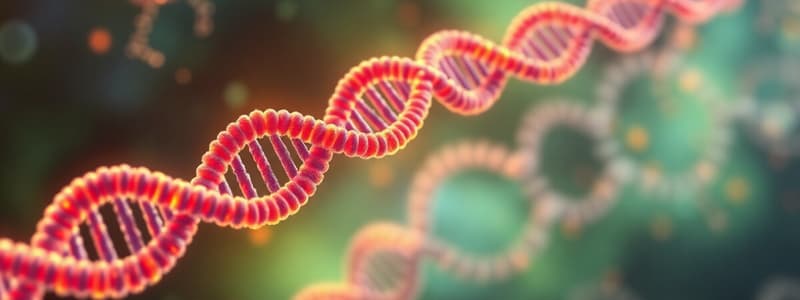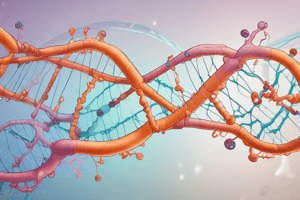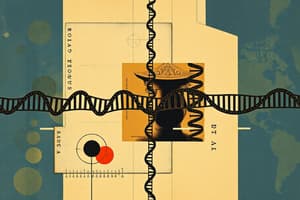Podcast
Questions and Answers
What is the role of Ran-GTP in nuclear export?
What is the role of Ran-GTP in nuclear export?
- It is hydrolyzed in the nucleus to release cargo proteins.
- It facilitates the transport of mRNA through the cytoplasm.
- It directly transports proteins out of the cell.
- It binds to exportin1 to increase affinity for cargo protein. (correct)
What must proteins possess to be exported from the nucleus?
What must proteins possess to be exported from the nucleus?
- A nuclear localization signal (NLS).
- A promoter binding region.
- A ribosomal binding site (RBS).
- A nuclear export signal (NES). (correct)
Which component stimulates the hydrolysis of GTP in the cytoplasm?
Which component stimulates the hydrolysis of GTP in the cytoplasm?
- Ran-GEF.
- Ran-GAP. (correct)
- Free exportin1.
- Export transporter.
What is the function of mRNP in nuclear export?
What is the function of mRNP in nuclear export?
How does exportin1 recognize the cargo protein for export?
How does exportin1 recognize the cargo protein for export?
What is the role of the 5' cap in mRNA processing?
What is the role of the 5' cap in mRNA processing?
Which sequence is recognized by cleavage and polyadenylation factors during mRNA processing?
Which sequence is recognized by cleavage and polyadenylation factors during mRNA processing?
During mRNA splicing, which components interact first with the mRNA?
During mRNA splicing, which components interact first with the mRNA?
What occurs during the slow phase of polyadenylation?
What occurs during the slow phase of polyadenylation?
Which step occurs right after the cleavage of the 3' end during polyadenylation?
Which step occurs right after the cleavage of the 3' end during polyadenylation?
What is the primary function of the proteins CPSF and CStF in mRNA processing?
What is the primary function of the proteins CPSF and CStF in mRNA processing?
What is the result of the transesterification reactions during splicing?
What is the result of the transesterification reactions during splicing?
Which component exits the spliceosome during the splicing process?
Which component exits the spliceosome during the splicing process?
What is the function of the U2AF protein in mRNA splicing?
What is the function of the U2AF protein in mRNA splicing?
Which of the following is true about self-splicing introns?
Which of the following is true about self-splicing introns?
How does the presence of multiple introns impact gene expression?
How does the presence of multiple introns impact gene expression?
In Drosophila, the presence of the Sxl protein in females leads to which splicing outcome?
In Drosophila, the presence of the Sxl protein in females leads to which splicing outcome?
What role do exonic splicing enhancers (ESEs) play in mRNA splicing?
What role do exonic splicing enhancers (ESEs) play in mRNA splicing?
What is a consequence of the absence of early Sxl protein in male Drosophila?
What is a consequence of the absence of early Sxl protein in male Drosophila?
How does the splicing mechanism differ between female and male Drosophila regarding the Dsx protein?
How does the splicing mechanism differ between female and male Drosophila regarding the Dsx protein?
Which statement is true regarding RNA editing as mentioned in the content?
Which statement is true regarding RNA editing as mentioned in the content?
What is the primary role of the nuclear pore complex (NPC)?
What is the primary role of the nuclear pore complex (NPC)?
Which modification involves the conversion of Cytosine to Uracil?
Which modification involves the conversion of Cytosine to Uracil?
What is required for proteins to enter the nucleus?
What is required for proteins to enter the nucleus?
What happens to Ran-GTP after it interacts with importin in the nucleus?
What happens to Ran-GTP after it interacts with importin in the nucleus?
At what molecular weight do molecules start requiring transport through the nuclear pore complex?
At what molecular weight do molecules start requiring transport through the nuclear pore complex?
What type of molecules freely diffuse through the nuclear pore complex?
What type of molecules freely diffuse through the nuclear pore complex?
What is the role of FG nucleoporins in the nuclear pore complex?
What is the role of FG nucleoporins in the nuclear pore complex?
Which of the following is a characteristic of the amino acid sequence of importin?
Which of the following is a characteristic of the amino acid sequence of importin?
Flashcards
mRNA Processing
mRNA Processing
The process of modifying pre-mRNA to create mature mRNA, which includes capping, cleavage, polyadenylation, and splicing.
5' Capping
5' Capping
The addition of a methylguanalate cap to the 5' end of pre-mRNA.
3' Cleavage and Polyadenylation
3' Cleavage and Polyadenylation
A process that cleaves the 3' end of pre-mRNA and adds a poly(A) tail.
Splicing
Splicing
Signup and view all the flashcards
Intron
Intron
Signup and view all the flashcards
Exon
Exon
Signup and view all the flashcards
Polyadenylation
Polyadenylation
Signup and view all the flashcards
5' cap
5' cap
Signup and view all the flashcards
Self-Splicing Introns
Self-Splicing Introns
Signup and view all the flashcards
Exon Splicing Enhancers (ESEs)
Exon Splicing Enhancers (ESEs)
Signup and view all the flashcards
Alternative Splicing
Alternative Splicing
Signup and view all the flashcards
Intronic Splicing Silencer
Intronic Splicing Silencer
Signup and view all the flashcards
Sxl Protein (Sex-lethal)
Sxl Protein (Sex-lethal)
Signup and view all the flashcards
Dsx Protein (Double-sex gene)
Dsx Protein (Double-sex gene)
Signup and view all the flashcards
Exotic Splicing Enhancer
Exotic Splicing Enhancer
Signup and view all the flashcards
RNA Editing
RNA Editing
Signup and view all the flashcards
ApoB-48
ApoB-48
Signup and view all the flashcards
Nuclear Localization Signal (NLS)
Nuclear Localization Signal (NLS)
Signup and view all the flashcards
Nuclear Pore Complex (NPC)
Nuclear Pore Complex (NPC)
Signup and view all the flashcards
FG Nucleoporins
FG Nucleoporins
Signup and view all the flashcards
Transport Receptor
Transport Receptor
Signup and view all the flashcards
Ran-GTP
Ran-GTP
Signup and view all the flashcards
Ran-GAP
Ran-GAP
Signup and view all the flashcards
Nuclear export signal
Nuclear export signal
Signup and view all the flashcards
Exportin1
Exportin1
Signup and view all the flashcards
mRNP export
mRNP export
Signup and view all the flashcards
Study Notes
RNA Processing II & Nucleocytoplasmic Transport
- RNA Processing II and Nucleocytoplasmic Transport lecture
- Lecture is PL2/3
- Lecturer: Holly J
- Course: BIOL200
- Date: November 20th, 2024
Housekeeping
- No lecture on December 4th
- End-of-term instructor review
- Submit questions by December 3rd at noon
- Sessions will be recorded
- Tutorials are one week behind the lecture schedule
mRNA Processing
- Modifications at the 5' and 3' ends of pre-mRNA are crucial for stability and protection
- Three major co-transcriptional steps:
- 5' capping
- 3' cleavage and polyadenylation
- RNA splicing
5' Capping
- Nascent mRNA emerges from the RNA exit channel (25bps)
- A methylguanalate cap is added by a capping enzyme that interacts with RNA Pol II CTD
- Protects the mRNA, facilitates nuclear export, allows recognition by translation initiation factors
3' Cleavage & Polyadenylation
- Poly(A) signal = AAUAAA, + G/U
- Polyadenylation factors (CPSF, CStF, CFI, CFII) recognize the signal
- 3' end is cleaved
- 3' end is recognized by Poly A Polymerase (PAP)
- Slow Phase: 12 A residues added to 3' end
- Rapid Phase: PolyA Binding Protein (PABP) adds around 200 A residues
mRNA Splicing
- U1 (intron splice site) and U2 (branch point) interact with mRNA
- U4, U5, U6 are recruited
- U1 & U4 exit (active spliceosome)
- Transesterification Reactions
- OH at branch point attacks 5' phosphate at the 1st intron residue, forming a lariat
- 3' end of exon attacks 5' end of following exon
- Release of mature mRNA, snRNAs, and intron
- Self-splicing introns: in some cases, introns have the capacity to self-splice without external snRNAs
mRNA Splicing Specificity
- Exon cross recognition complex
- U2AF: Important for splicing efficiency
- SR Proteins: Contain RRM domains and arginine/serine rich domains
- Cooperative binding of U1 to the 5' splice site and U2 to the branch point
- Binding to exonic splicing enhancers (ESEs)
- ESES: sequences within exons that promote splicing
Alternative Splicing
- The presence of multiple introns allows for multiple variations of a protein from a single gene (protein isoforms)
- Example: Sexual differentiation in Drosophila
- Sxl protein is only present in female embryos (early development)
- Binding site (intronic splicing silencer) blocks use of splice site
- Later in development, the gene is active in males and females
- Males:
- Absence of early Sxl protein => sex-lethal mRNA is spliced to make mRNA with a stop codon => no functional Sxl protein
- No functional transformer protein
- Females:
- Presence of early Sxl protein => exon 3 is skipped => functional Sxl protein => binding of Sxl to ISS skips exon 2 => functional transformer protein
- Dsx protein (double-sex gene)
- Females: complex of tra, Rbp1 and tra2 direct splicing, cleavage, and alt polyadenylation => short, female-specific Dsx
- Binding site = exotic splicing enhancer
- Males: no tra => exon 4 is skipped => longer, male-specific Dsx
RNA Editing
- Sequence of mature mRNA sometimes differs from the DNA's coding regions sequence
- Adenosine to Inosine (A -> I) OR Cytosine to Uracil (C -> U)
- Ex: Editing of apoB pre-mRNA changes C->U at position 666 in intestinal cells
- Shorter apoB-48 has N-terminal domains associated with lipids
Nucleo-Cytoplasmic Transport
Nuclear Pore Complex
- Proteins synthesized in the cytoplasm need to exit the nucleus (and potentially re-enter)
- Nuclear Pore Complex (NPC): made up of nucleoporins
- Nuclear basket
- Aqueous pore
- FG nucleoporins: extended regions (Phe-Gly repeats + hydrophilic regions) form permeability barrier
- Molecules up to 60kDA freely diffuse; larger molecules need to be transported
Nuclear Import
- Proteins wanting to enter the nucleus require a nuclear localization signal (NLS)
- Free importin binds to NLS on cargo protein, forming a complex
- Complex interacts with FG repeats in NPC channel
- Importin interacts with Ran-GTP causes cargo protein release (decreased affinity)
- Importin-Ran-GTP complex diffuses back to cytoplasm
- Ran interacts with Ran-GAP, hydrolyzes GTP to GDP, importin is released
- Ran-GDP returns to nucleus, interacts with Ran-GEF, causing GDP to be exchanged for GTP
Nuclear Export
- Proteins wanting to exit the nucleus require a nuclear export signal (NES)
- Free exportin1 forms complex with Ran-GTP and cargo protein (increased affinity)
- Complex interacts with FG repeats in NPC channel
- In cytoplasm, complex encounters Ran-GAP, stimulating GTP hydrolysis, cargo is released
- Exportin1 and Ran-GDP transported back to nucleus
- Ran-GEF stimulates conversion of Ran-GDP to GTP
mRNP Export
- Once mRNA processing is complete, it remains associated with proteins (mRNP complex)
- Exporter binds RNA with mRNP proteins during elongation (prior to processing)
- Forms a domain that interacts with FG repeats, allowing diffusion across NPC
Questions?
Studying That Suits You
Use AI to generate personalized quizzes and flashcards to suit your learning preferences.



